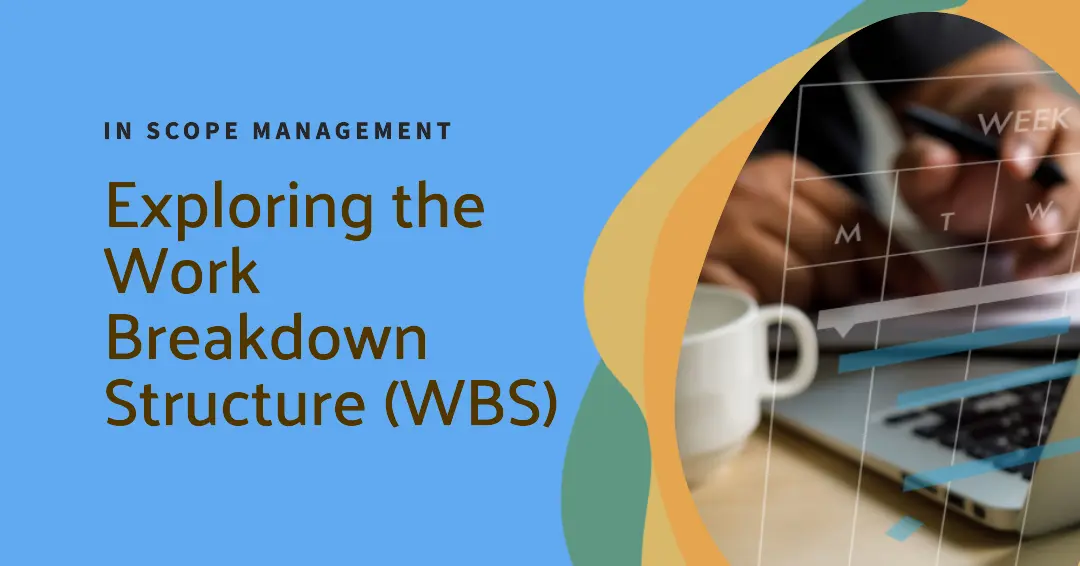To find out how Artificial Intelligence is changing the Project Management landscape, you may enjoy reading this article https://www.shaunstoltz.com/did-artificial-intelligence-just-change-everything-about-project-management/
I. Introduction
Hello, fellow project managers and enthusiasts! Have you ever struggled with defining the scope of a project, ensuring all stakeholders are on the same page, and keeping everything organized? Well, you’re not alone. In the exciting world of project management, there’s an essential tool that can help you overcome these challenges: the Work Breakdown Structure, or WBS. In this blog post, we’ll dive deep into the WBS, exploring its importance in project scope management and how you can use it to your advantage.
A. Brief explanation of project scope management
Project scope management is a vital part of project management, as it involves defining and controlling the work that must be done to achieve project objectives. The project scope sets the boundaries of what will and will not be included in the project, establishing a baseline for monitoring and controlling the project’s progress. Without effective scope management, projects can easily spiral out of control, leading to cost overruns, missed deadlines, and ultimately, unhappy clients.
B. Importance of the Work Breakdown Structure (WBS) in scope management
Enter the Work Breakdown Structure! The WBS is a crucial element in project scope management, allowing you to break down the project into smaller, more manageable components. By doing so, you’ll gain a clearer understanding of the tasks involved and the resources needed, making it easier to plan, schedule, and monitor the project. Moreover, a well-constructed WBS can facilitate communication among team members and stakeholders, ensuring everyone is on the same page and working towards the same objectives. So, without further ado, let’s dive into the world of WBS and learn how it can make your project management life a whole lot easier!
II. What is a Work Breakdown Structure (WBS)?
As we delve deeper into the realm of Work Breakdown Structures, you might be wondering what exactly a WBS is and how it fits into the bigger picture of project management. Fret not! In this section, we’ll uncover the mysteries behind the WBS and reveal the essential components that make it tick.
A. Definition of WBS
A Work Breakdown Structure, or WBS, is a hierarchical decomposition of a project into smaller, more manageable components. Think of it as a visual map or a tree-like structure that represents the project’s work elements, with each branch representing a deliverable or a work package. The top level of the tree represents the overall project, while lower levels represent the tasks and subtasks needed to complete each deliverable. Essentially, a WBS is a way of breaking down the project into bite-sized pieces that are easier to understand, plan, and manage.
B. Purpose of WBS in project management
Now that you have a basic understanding of what a WBS is, let’s talk about why it’s essential in project management. The WBS serves several vital purposes, including:
- Defining the project scope: By breaking the project down into smaller components, the WBS helps you establish a clear and concise scope, ensuring that you don’t miss any crucial elements or include any unnecessary work.
- Facilitating project planning and scheduling: With a well-structured WBS, you can more easily estimate the time, resources, and costs associated with each task, making project planning and scheduling a breeze.
- Enhancing communication and collaboration: The WBS provides a common language and framework for team members and stakeholders, promoting better understanding and collaboration throughout the project lifecycle.
C. Components of a WBS
A typical WBS consists of the following components:
- Work packages: These are the lowest-level components in the WBS hierarchy and represent specific tasks or activities required to complete a deliverable.
- Deliverables: These are the tangible or intangible outputs of the project, such as a product, service, or document.
- Milestones: These are significant events or accomplishments that mark the completion of specific project phases or deliverables.
With the basics of the WBS under your belt, you’re now ready to explore its role in project scope management and learn how to create and use a WBS effectively. So, let’s keep the momentum going and dive into the next section!
III. The Role of WBS in Scope Management
At this point, you might be wondering how the Work Breakdown Structure specifically ties into scope management. Excellent question! In this section, we’ll examine the various ways the WBS can be your secret weapon in managing your project’s scope effectively.
A. Defining the project scope
One of the primary roles of a WBS in scope management is helping you define the project scope clearly and concisely. By decomposing the project into smaller components, you can ensure that all necessary work is included, and no irrelevant tasks are accidentally incorporated. This well-defined scope serves as a baseline against which you can track progress and measure performance. Remember, a clear project scope is the foundation of a successful project!
B. Ensuring alignment with project objectives
A well-constructed WBS doesn’t just help you define the scope; it also ensures that all work included in the project is aligned with the project’s objectives. By tying each work package and deliverable back to the project’s goals, you can make sure that your team’s efforts are always focused on what truly matters. This alignment is critical for maintaining stakeholder satisfaction and delivering the desired results.
C. Facilitating communication with stakeholders
We all know that effective communication is the key to successful project management. A WBS can be an invaluable tool for facilitating clear and concise communication with team members, stakeholders, and even clients. By providing a visual representation of the project’s components and their relationships, the WBS helps everyone involved in the project understand the scope, the deliverables, and their respective responsibilities. This shared understanding can significantly reduce the risk of misunderstandings, miscommunications, and scope creep.
As you can see, the WBS plays a crucial role in project scope management by helping you define the scope, ensure alignment with project objectives, and facilitate communication among stakeholders. But how do you create a WBS, and what are some best practices to keep in mind? Fear not, my fellow project management enthusiasts! In the next section, we’ll dive into the nitty-gritty of creating a WBS that’s both effective and efficient. So, stay tuned and let’s continue our exciting journey into the world of Work Breakdown Structures!
IV. Creating a Work Breakdown Structure
Alright, it’s time to roll up our sleeves and dive into the practical aspects of creating a Work Breakdown Structure. As you embark on this creative journey, remember that the primary goal is to break down your project into manageable components that are easy to understand and plan. So, without further ado, let’s explore the steps and best practices for creating a fantastic WBS!
A. Identifying project deliverables
The first step in creating a WBS is to identify your project’s key deliverables. These are the tangible or intangible outputs that the project is expected to produce, such as a product, service, or document. Start by reviewing your project’s objectives and requirements, and then list out the major deliverables that will help you achieve those goals. Keep in mind that these deliverables should be outcome-focused, rather than task-focused.
B. Decomposing deliverables into smaller work packages
Now that you have your project deliverables, it’s time to break them down into smaller work packages. These work packages represent the individual tasks or activities required to complete each deliverable. Start by taking each deliverable and decomposing it into the sub-tasks necessary for its completion. Remember to strike a balance between breaking down the work packages into small enough components to manage effectively while avoiding excessive detail that may become overwhelming.
C. Assigning resources and responsibilities
Once you’ve broken down your deliverables into work packages, it’s time to assign resources and responsibilities. For each work package, determine the resources needed, such as personnel, equipment, or materials, and allocate them accordingly. Additionally, assign clear responsibility for each work package to a specific team member or group. By doing this, you’ll help ensure that everyone is aware of their roles and responsibilities, contributing to a smoother project execution.
D. Best practices for creating a WBS
As you create your WBS, keep these best practices in mind to ensure its effectiveness:
- Use a consistent numbering system: This helps maintain organization and makes it easy to reference specific work packages or deliverables.
- Keep work packages manageable: Ideally, a work package should be small enough to be easily estimated and managed but large enough to avoid micromanagement.
- Keep it flexible: Remember that projects can change, and your WBS should be adaptable to accommodate those changes.
- Involve your team: Engage team members in the WBS creation process to ensure their buy-in and gather valuable input.
By following these steps and best practices, you’ll be well on your way to creating a WBS that not only helps you manage your project scope effectively but also contributes to a successful project outcome. Up next, let’s explore how to use your shiny new WBS to estimate project duration and cost, develop a project schedule, and monitor and control your project’s progress!
V. Using the Work Breakdown Structure
Congratulations! You’ve created a fantastic Work Breakdown Structure, and you’re ready to harness its power to bring your project management game to the next level. But how exactly do you use your WBS to estimate project duration and cost, develop a project schedule, and monitor and control your project’s progress? Fear not, my fellow project managers! In this section, we’ll explore the many ways you can leverage your WBS for project success.
A. Estimating project duration and cost
One of the main benefits of a WBS is that it enables you to estimate the duration and cost of your project more accurately. By breaking the project down into manageable work packages, you can assess the time and resources required for each task more easily. To estimate duration, consider factors such as task complexity, resource availability, and dependencies between tasks. For cost estimation, take into account the resources assigned to each work package, as well as any additional expenses, such as materials or equipment. Armed with these estimates, you’ll be well-equipped to develop a realistic project budget and timeline.
B. Developing a project schedule
With your project duration and cost estimates in hand, you can now use your WBS to develop a detailed project schedule. Start by identifying dependencies between work packages and determining the critical path – the sequence of tasks that must be completed on time to avoid delaying the project. Next, allocate resources and assign deadlines to each work package, taking into account any constraints or risks that may impact the schedule. Finally, communicate the project schedule to your team and stakeholders to ensure everyone is aligned and working towards the same objectives.
C. Monitoring and controlling project progress
Your WBS isn’t just a planning tool; it’s also an invaluable resource for monitoring and controlling your project’s progress. By comparing the actual performance of your project against the WBS baseline, you can quickly identify deviations, assess their impact, and take corrective action as needed. This proactive approach to project management helps you stay on track, avoid scope creep, and ultimately deliver a successful project that meets or exceeds expectations.
D. Updating the WBS during project execution
Projects are rarely set in stone, and your WBS should be adaptable to accommodate changes that may arise during project execution. As new information becomes available or project priorities shift, update your WBS to reflect these changes and communicate them to your team and stakeholders. By keeping your WBS up-to-date and aligned with project objectives, you’ll help ensure a smooth and successful project outcome.
Now that you’re well-versed in using the Work Breakdown Structure to estimate project duration and cost, develop a project schedule, and monitor and control project progress, you’re ready to tackle even the most complex projects with confidence! But before we wrap up, let’s take a moment to reflect on the advantages of using a WBS and some of the challenges and limitations you may encounter in scope management. Onward to the next section!
VI. Advantages of Using a Work Breakdown Structure
By now, you’ve gained a solid understanding of the Work Breakdown Structure, its role in project scope management, and how to create and use it effectively. But it’s also essential to appreciate the many advantages that a well-crafted WBS can bring to your project management endeavors. In this section, let’s celebrate the wonders of the WBS and explore the benefits it can deliver to your projects.
A. Improved project planning and organization
The WBS is a powerful tool for organizing the myriad tasks, deliverables, and resources involved in a project. By breaking the project down into manageable work packages, the WBS allows you to gain a clearer understanding of the project’s scope and the resources needed to complete it. This enhanced organization leads to more accurate estimates, better resource allocation, and ultimately, a more streamlined and efficient project execution.
B. Enhanced risk management
Risk management is a critical aspect of project management, and the WBS can play a vital role in identifying and mitigating potential risks. By providing a detailed overview of the project’s work packages and their interdependencies, the WBS helps you pinpoint areas of uncertainty or complexity that may pose risks to the project’s success. Armed with this knowledge, you can proactively address these risks and develop contingency plans to minimize their impact.
C. Better resource allocation and utilization
The WBS offers a comprehensive view of the resources required for each work package, making it easier to allocate and manage these resources effectively. By matching resources to the appropriate tasks and monitoring their utilization throughout the project, you can ensure that your team is working efficiently and avoiding costly over-allocations or under-utilizations.
D. Increased stakeholder understanding and commitment
Finally, the WBS can be a powerful communication tool that promotes better understanding and commitment among team members, stakeholders, and clients. By visually presenting the project’s components and their relationships, the WBS enables everyone involved to gain a clear and concise understanding of the project’s scope, deliverables, and responsibilities. This shared understanding helps to foster collaboration, minimize misunderstandings, and ultimately, contribute to a more successful project outcome.
As you can see, the Work Breakdown Structure offers a wealth of benefits that can elevate your project management skills to new heights. However, it’s essential to acknowledge that the WBS is not without its challenges and limitations in scope management. In the next section, we’ll explore some of these potential pitfalls and discuss how to overcome them to make the most of your WBS.
VII. Challenges and Limitations of the WBS in Scope Management
While the Work Breakdown Structure is undeniably a powerful tool for project scope management, it’s important to recognize that it’s not a magic wand that guarantees success. Like any tool, the WBS has its limitations and challenges that you, as a project manager, need to be aware of and prepared to tackle. In this final section, let’s explore some of these potential pitfalls and discuss strategies to overcome them and maximize the effectiveness of your WBS.
A. Creating an overly detailed or superficial WBS
One of the most common challenges when creating a WBS is striking the right balance between detail and manageability. An overly detailed WBS can lead to micromanagement, making it difficult to focus on the bigger picture, while a superficial WBS may not provide enough information to effectively plan and manage the project. To overcome this challenge, focus on breaking the project down into work packages that are small enough to be easily estimated and managed, but large enough to avoid getting lost in the weeds.
B. Maintaining consistency and standardization
Another challenge when creating and using a WBS is maintaining consistency and standardization across projects and within your organization. Without a consistent approach, it can be difficult to compare projects, share best practices, and build on previous successes. To address this challenge, develop a standardized WBS template and guidelines for your organization, and encourage collaboration and knowledge sharing among project managers and teams.
C. Adapting to changes in project scope
Projects are rarely static, and changes in scope, priorities, or requirements can have a significant impact on your WBS. Adapting your WBS to accommodate these changes can be challenging, especially when trying to maintain a clear and concise scope. To overcome this challenge, make sure your WBS is flexible and adaptable, and be prepared to update it as needed to reflect changes in the project landscape. Don’t forget to communicate these changes to your team and stakeholders to ensure everyone remains aligned and committed to the project’s success.
D. Overcoming resistance to WBS adoption
Last but not least, you may encounter resistance from team members or stakeholders who are unfamiliar or uncomfortable with the WBS approach. To address this challenge, take the time to educate and involve them in the WBS creation process. By explaining the benefits of the WBS and demonstrating how it can contribute to a more successful project outcome, you can help build buy-in and support for this valuable project management tool.
In conclusion, the Work Breakdown Structure is a powerful and versatile tool that can greatly enhance your project scope management efforts. By understanding its challenges and limitations, and implementing strategies to overcome them, you can unlock the full potential of the WBS and take your project management skills to new heights. So, go forth and conquer, my fellow project managers, and may the power of the WBS be with you on your journey to project success!
VIII. Conclusion: Embracing the Power of the Work Breakdown Structure
We’ve come a long way together, my fellow project management enthusiasts! Throughout our journey, we’ve explored the fascinating world of the Work Breakdown Structure and its critical role in project scope management. From understanding the basics of the WBS to delving into its creation, usage, advantages, and challenges, we’ve armed ourselves with the knowledge and tools necessary to harness the power of the WBS for project success.
As we part ways and return to our respective project management adventures, let’s take a moment to reflect on the key takeaways from our deep dive into the WBS:
- The WBS is a powerful tool for breaking down a project into manageable components, helping to define the project scope, ensure alignment with project objectives, and facilitate communication among stakeholders.
- Creating a WBS involves identifying project deliverables, decomposing them into smaller work packages, and assigning resources and responsibilities. Remember to follow best practices, such as using a consistent numbering system and keeping work packages manageable.
- The WBS can be used to estimate project duration and cost, develop a project schedule, and monitor and control project progress. Be prepared to adapt and update your WBS as needed to accommodate changes in project scope or priorities.
- Embrace the advantages of using a WBS, such as improved project planning and organization, enhanced risk management, better resource allocation and utilization, and increased stakeholder understanding and commitment.
- Be aware of the challenges and limitations of the WBS in scope management, and implement strategies to overcome them, such as striking the right balance between detail and manageability, maintaining consistency and standardization, and addressing resistance to WBS adoption.
As you move forward with your project management journey, remember that the WBS is not a one-size-fits-all solution but a versatile and adaptable tool that can be tailored to meet the unique needs of your projects. By embracing the power of the Work Breakdown Structure and incorporating it into your project management toolkit, you’ll be well-equipped to tackle even the most complex projects with confidence and skill.
So, go forth and conquer, my friends, and may your projects be filled with clarity, organization, and success! And remember, when in doubt, always ask yourself: “What would my WBS do?” Happy project managing!
Find out more about Shaun Stoltz https://www.shaunstoltz.com/about/
This post was written by an AI and reviewed/edited by a human.



